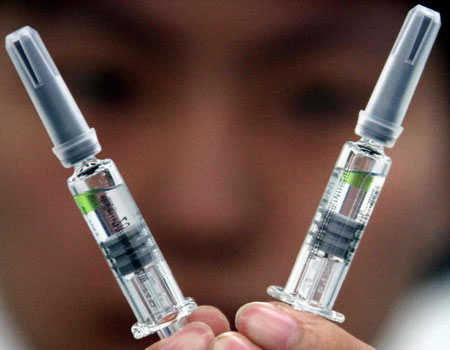Vaccines against influenza A / H1N1 cause mild side effects
Chinese health officials recorded 14 cases of side effects of the vaccine against A / H1N1 flu when the world's first universal vaccination program was conducted here.
On September 23, about 39,000 Beijing residents were vaccinated.
There are four possible side effects related to the vaccine, Liang Xiaofeng, director of the immune center of the Chinese Center for Disease Control and Prevention (CDC), said on September 23. Previously, only one side effect was noted in the vaccine test.
Side effects were mild, including pain, nausea, shortness of breath and fever, Liang said. " We are checking the exact cause ". Adverse reactions can be caused by many causes, such as the individual's physical condition, physiological effects, current conditions and the quality of the vaccine.

(Artwork: Chinadaily.com.cn)
" 14 cases of drug side effects were not related to vaccine quality ," Liang said.
" The safety of the vaccine is still being tested in a widespread vaccination program ," said Shin Young Soo, director of the Western Pacific Region of the World Health Organization (WHO). in Hong Kong.
" When vaccinating millions and millions of people, it is also likely that people will have serious side effects of the drug, " Shin said. Accordingly, serious side effects include paralysis and nerve damage.
When tens of millions of people will be exposed to the flu virus in the fall and winter, the Chinese government intends to fully prepare the vaccine for 100 million people by the end of 2009, Deng Haihua, head of the press department. Chinese Ministry of Health said.
Starting September 28, Beijing will vaccinate 100,000 students to attend National Day celebrations on October 1. Sources say soldiers may have been vaccinated earlier. Nationally, the vaccination will begin after the holiday season, Mr. Liang said.
The health official said that it is uncertain about the safety of vaccines with the " sensitive " group of pregnant women and nursing women.
- Vaccination against H1N1 can cause neurological disorders
- WHO is concerned about side effects from China's H1N1 vaccine
- When do children need vaccines or anti-H1N1 drugs?
- New influenza A / H1N1 vaccine: There is no less concern
- Latest assessment of vaccine side effects
- Vietnam influenza A / H1N1 vaccine may be released after 6 months
- Vietnam successfully studied influenza A / H5N1 vaccine and influenza A / H1N1
- There is going to be a vaccine against all flu
- How dangerous is swine flu?
- Thailand's cabinet meets urgently, spending 25 million USD against influenza A / H1N1
- Influenza A / H1N1 outbreak in many parts of the world
- 3 common misunderstandings about vaccines
 Green tea cleans teeth better than mouthwash?
Green tea cleans teeth better than mouthwash? Death kiss: This is why you should not let anyone kiss your baby's lips
Death kiss: This is why you should not let anyone kiss your baby's lips What is salmonellosis?
What is salmonellosis? Caution should be exercised when using aloe vera through eating and drinking
Caution should be exercised when using aloe vera through eating and drinking